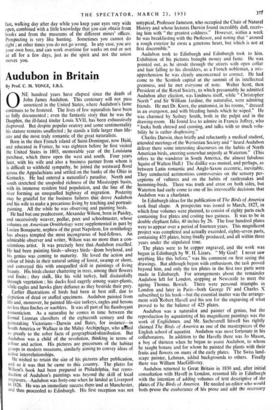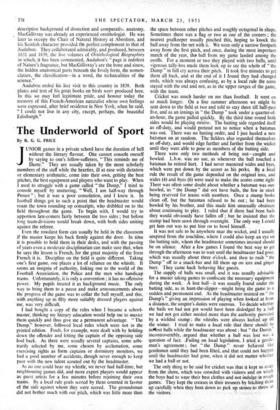Audubon in Britain
By Prof. C. M. YONGE, F.R.S.
0 NE hundred years have elapsed since the death of John James Audubon. This centenary will not pass unnoticed in the United States, where Audubon's fame continues to be fostered. The lives of few naturalists have been so fully documented ; even the fantastic story that he was the Dauphin. the ill-fated titular Louis XVII, has been exhaustively disproved. But despite popular oratory and some sentimentality his stature remains unaffected ; he stands a little larger than life- size and the most truly romantic of the great naturalists. Born in the then French island of Saint-Domingue, now Haiti. and educated in France, he was eighteen before he first visited the United States in 1803, memorable year of the Louisiana purchase, which threw open the west and south. Four years later, with his wife and also a business partner from whom it is difficult to withhold sympathy. he joined the westward flood across the Appalachians and settled on the banks of the Ohio in Kentucky. He had entered a naturalist's paradise. North and south stretched the unspoiled richness of the Mississippi basin, with its immense resident bird population, and the line of the river forming an unequalled highway of migration. Posterity may be grateful for the business failures that drove Audubon and his wife to make a precarious living by teaching and portrait- painting. All the while he was observing and painting birds. He had but one predecessor, Alexander Wilson, born in Paisley. and successively weaver, pedlar, poet and schoolmaster, whose volumes on American Ornithology were supplemented in part by Lucien Bonaparte, nephew of the great Napoleon, for ornithology has always tempted the most incongruous of bed-fellows. An admirable observer and writer, Wilson was no more than a con- scientious artist. It was precisely here that -Audubon excelled. He had been painting birds—always birds—Atom boyhood, and his genius was coming to maturity. He loved the action and colour of birds in their natural setting of forest, swamp or shore, and conveyed this with unequalled skill in paintings of living beauty. His birds cluster chattering in trees, among their flowers Ind fruits ; they stalk, like his wild turkey, half disdainfully through vegetation ; his ducks feed eagerly among water-plants, %slide eagles and hawks glare defiance as they bestride their prey. Earlier illustrations of birds had been at best stiff, due to depiction of dead or stuffed specimens. Audubon painted from life and, moreover, he painted life-size turkeys, eagles and herons no less than finches or warblers. It was all part of his flamboyant romanticism. As a naturalist he comes in time between the formal Linnean classifiers of the eighteenth century and the painstaking Victorians—Darwin and. Bates, for instance—in South America or Wallace in the Malay Archipelago, who adtled co greatly to the sober facts of geographicaLvdistribution. But Audubon was a child of the revolution, thinking in terms of colour and action. His pictures are precursors of the habitat ;groups in modern museums. similarly aiming; to convey ideas of active interrelationships. He wished to retain the size of his pictures after publication, and so it was that he came to this country. The plates for Wilson's book had been prepared in Philadelphia. but repro- duction of Audubon's paintings was beyond the skill of local engravers. , Audubon was forty-one when he landed at Liverpool lri 1826. He was an immediate success there 'and at Manchester, and then proceeded to Edinburgh. His first reception was not untypical, Professor Jameson, who occupied the Chair of Natural History and whose lectures Darwin found incredibly dull, receiv- ing him with " the greatest coldness." However, within a week he was breakfasting with the Professor, and noting that " around a rough exterior he owns a generous heart, but which is not at first discernible."
Audubon took to Edinburgh and Edinburgh took to him. Exhibition of his pictures brought money and fame. He was pointed out, as he strode through the streets with open collar and hair falling to his shoulders, as a French nobleman, a mis- apprehension he was clearly unconcerned to correct. He had come to the Scottish capital at the summit of its intellectual greatness, and he met everyone of note. Walter Scott. then President of the Royal Society, to which presumably he admitted Audubon after election, was kindness itself, while Christopher North " and Sir William Jardine, the naturalist, were admiring friends. He met Dr. Knox, the anatomist, in his rooms, " dressed in an overgown, and with bleeding hands which he wiped." He was charmed by Sydney Smith, both in the pulpit and in the drawing-room. He found less to admire in Francis Jeffrey, who " looks both shrewd and cunning, and talks with so much volu- bility he is rather displeasing."
Charles Darwin, then briefly and reluctantly a medical student, attended meetings of the Wernerian Society and " heard Audubon deliver there some interesting discourses on the habits of North American birds, sneering somewhat unjustly at Waterton." (This refers to the wanderer in South America, the almost fabulous Squire of Walton Hall.) The dislike was mutual, and perhaps, as between Latin romantic and Anglo-Saxon eccentric, inevitable. They conducted acrimonious controversies on the sensory per- ceptions of vultures and on the habits of rattlesnakes and humming-birds. There was truth and error on both sides, but Waterton had early come to one of his irrevocable decisions that Audubon was a charlatan.
In Edinburgh ideas for the publication of The Birds of America took final shape. A prospectus was issued in March. 1827. in which four volumes were planned, to consist of eighty parts each containing five plates and costing two guineas. It was to be in double elephant folio. 40 inches by 26. The four hundred plates were to appear over a period of fourteen years. This magnificent project was completed and actually exceeded, eighty-seven parts, containing 435 plates, being finally produced, and all within three years under the stipulated time.
The plates were to be copper engraved, and the work was begun in Edinburgh by W. H. Lizars. " My God! I never saw anything like this before." was his comment on first seeing the drawings. But although begun with enthusiasm, the task proved beyond him, and only the ten plates in the first two parts were made in Edinburgh. For arrangements about the remainder Audubon left for London, stopping at Newcastle to meet the ageing Thomas Bewick. There were personal triumphs in London and later in Paris—both George IV and Charles X subscribedjo his book—but the essential matter was the arrange- ment with 'Robert Havell and his son for the engraving of what proved to be the balance of 425 plates.
Audubon was a naturalist and painter of genius, but the reproduction by aquatinting of his magnificent paintings was the work Of Englishmen. and Mr. Sacheverell Sitwell has rightly claimed The Birds of America as one of the masterpieces of the English school of aquatint. Audubon was most fortunate in his collaborators. In addition to the Havells there was Jo Mason, a boy of thirteen when he began to assist Audubon, to whom he taught botany and for whom he painted the plants with their fruits and flowers on many of the early plates. The Swiss land- scape painter. Lehman, added backgrounds to others. Finally there was William MacGillivray.
Audubon returned to Great Britain in 1830 and, after initial consultation with Havell in Liondon, resumed life in Edinburgh with the intention of adding volumes of text descriptive of the plates of The Birds of America. He needed an editor who would both .prune the exuberance of his prose and add the necessary descriptive background of dissection and comparativ.. anatomy. MacGillivray was already an experienced ornithologist. He was later to occupy the Chair of Natural History at Aberdeen, and his Scottish character provided the perfect complement to that of Audubon. They collaborated admirably, and produced, between .1831 and 1839, the five volumes of Ornithological Biographies in which, it has been commented. Audubon's " page is redolent of Nature's fragrance, but MacGillivray's are the bone and sinew, the hidden anatomical parts beneath the lovely form, the nomen- clature, the classification—in a word, the technicalities of the science."
Audubon ended his last visit to this country in 1839. I3oth plates and text of his great books on birds were produced here. In this we may feel legitimate pride, and honour today the memory of this French-American naturalist whose own feelings were expressed, after brief residence in New York, when he said, " I could not live in any city, except, perhaps, the beautiful Edinburgh."



































 Previous page
Previous page